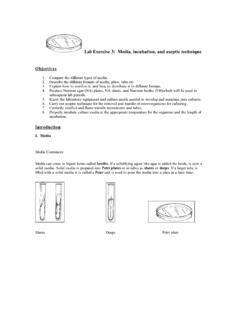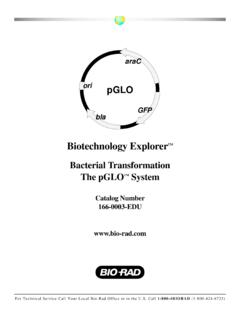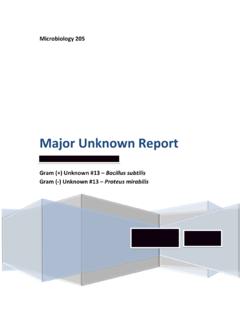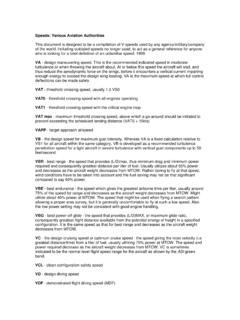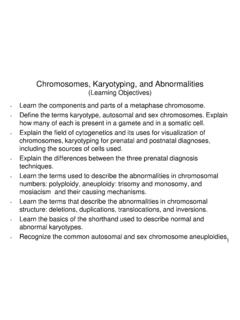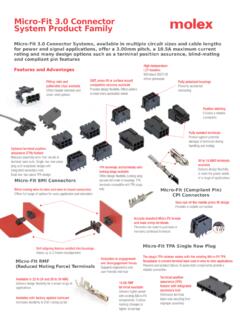Transcription of Staphylococcus S. aureus S. epidermidis saprophyticus S ...
1 Page 1 of 5 Miramar College Biology 205 Microbiology Staphylococcal Unknowns Background The identification of bacterial pathogens, particularly from closely related non pathogens is extremely important to the field of medical microbiology. In order to do this, selective and differential media are often used. Particularly when members of the normal flora can be opportunistic pathogens, it is important to have on hand easy ways of identification so that useful and appropriate treatment can be begun. The bacterial genus Staphylococcus contains three species of medical importance: S. aureus , S. epidermidis and S.
2 saprophyticus . Of these three, only S. aureus is typically considered to be pathogenic, except under special circumstances. All three, however, can be found residing on the skin and mucous membranes of healthy adults. Staphylococci are particularly well suited to this environment because they are facultative halophiles and can grow in media containing up to 10% NaCl. This capability can be used to isolate staphylococci from a mixed culture of organisms or from a patient sample It is important to note, however, that microscopic examination must confirm the presence of non spore forming staphylococci before biochemical testing can be performed.
3 Once a staphylococcal organism has been isolated, the species can be determined by performing a few simple biochemical tests, including mannitol fermentation. Because both salt tolerance and mannitol fermentation are useful criteria for identifying members of the staphylococci, a medium which examines both of these characteristics is commonly used, Mannitol Salt Agar (Figure 1). Table 1: Differential characteristics of the genus Staphylococcus . Organism S. aureus S. epidermidis S. saprophyticus Coagulase positive negative negative Novobiocin Susceptibility (>17 mm) sensitive sensitive resistant Mannitol Fermentation positive negative Positive / variable toxin Production (hemolytic) positive negative negative Figure 1: The selective and differential medium, Mannitol Salt Agar.
4 This medium is selective for salt tolerant organisms, because it contains NaCl and differential because the fermentation of mannitol in the medium results in a lowering of the pH and a change in the color of the pH indicator, phenol red, from reddish pink to yellow. Both organisms are salt tolerant, but only the organism on the right is a mannitol fermenter. Introduction Staphylococci In this experiment, you will be attempting to isolate and identify staphylococci from three sources: an unknown organism; your nose and a fomite. You will identify each of these as one of the three staphylococcal species discussed above.
5 You will utilize several media to make your analysis. First you will use selective and differential media which exploit the halotolerant nature of the genus Staphylococcus using m staph broth, containing 10% NaCl. Also you will use plates of SM110 agar. This is an agar with salt. It will allow you to observe the cultural characteristics of your unknown. A third media is both selective and differential; mannitol salt agar, which contains the fermentable sugar mannitol, the pH indicator phenol red and NaCl. Additionally you will test your organisms for their susceptibility to the antibiotic novobiocin and determine whether or not your isolate produces toxin, which causes hemolysis.
6 Finally, you may inoculate your organism into rabbit plasma, to test for the presence of the pathogenic enzyme coagulase (Figure 2). Page 2 of 5 Figure 2: Positive (upper) and negative (lower) results for coagulase production in rabbit plasma. Objectives 1. Identify each of the organisms worked with in this lab exercise. 2. Understand the use of differential and selective media in the identification of bacteria and the enrichment of such cultures for organisms of interest. 3. Understand the inoculations used throughout this laboratory exercise, use Table 2 as a study tool. 4. Understand the use of a dichotomous key and other data (including data tables) in determining species identification.
7 Protocol A summary of the media and results for all the staphylococcal, streptococcal and enteric inoculations can be found in Table 2. A diagram of the inoculations for the staphyloccocal inoculations can be found in Figure 3. Staphylococci Day One Individual Supplies 2 sterile cotton swabs positive control organism 3 m staph broths 1. Using sterile technique, wet a cotton swab with your m staph broth. Gently swab the lowest portion of the inside of your nose. 2. Place the swab into the m staph broth and label it accordingly. 3. Using a second tube of m staph broth, and using sterile technique, wet a clean sterile cotton swab.
8 Swab the surface of any fomite in the lab. 4. Place the swab into the second tube of m staph broth and label it accordingly. 5. Inoculate your positive control into m staph broth. 6. Incubate both tubes at 37 C for 48 hours. Day Two Individual Supplies Mannitol Salt Agar plate unknown control organism SM110 agar plate nose & fomite m staph broths 1. Using your inoculating loop, streak for isolation your fomite, nose and unknown control organisms onto separate thirds of both your SM110 and your Mannitol Salt Agar (MSA) plates. See drawing below. Page 3 of 5 2. Incubate the plates at 37 C for 48 hours. Day Three Individual Supplies share Blood Agar plates 1 NA plates & antibiotic disk dispenser containing Novobiocin 1.
9 Using Figure 1 as a reference, examine your SM 110 plate for a gold colony and check your MSA growth to determine salt tolerance and mannitol fermentation for all three of your organisms. Gram stain all isolated colonies that appear different until you find one exhibiting morphology & arrangement indicative of staphylococcal bacteria. Only those organism which are confirmed as staphylococci should be further cultured and tested. 2. Organisms that ferment mannitol and look golden should be subcultured onto a third of a blood agar plate and inoculated into rabbit plasma to test for hemolysis and coagulase production respectively.
10 A. Rabbit plasma should be incubated in the 37 C water bath and checked every 30 minutes for coagulation, up to 24 hours. 3. All organisms showing growth on MSA should be checked for Novobiocin sensitivity using NA plate for each isolate. Refer to Lab on Chemical Control of Growth for instructions on how to plate for antibiotic sensitivity. Day Four 1. Record all relevant data. Figure 3: Inoculation diagram for the staphylococcal isolates. Page 4 of 5 Data Collection and Analysis Staphylococci 1. In a table similar to that below, record the results of each test performed in this experiment. Under Gram Stain indicate cellular arrangement as well as Gram reaction.
